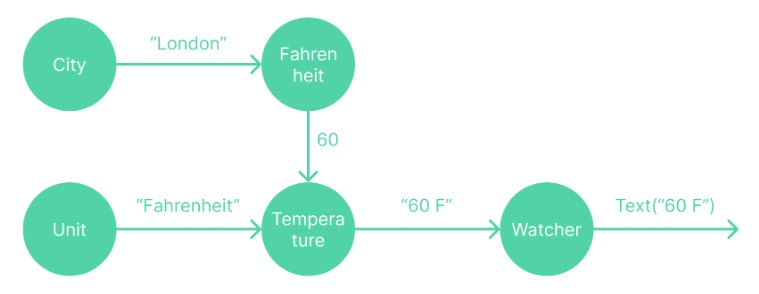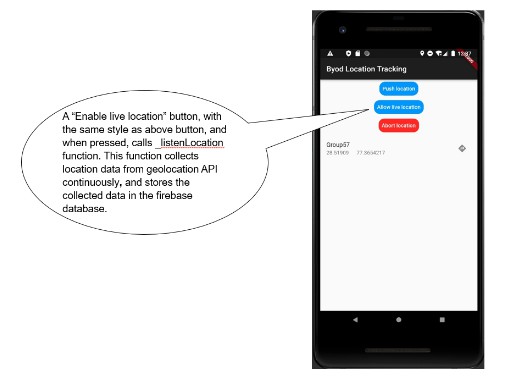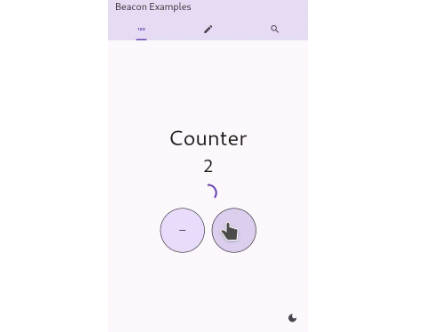Creator is a state management library that enables concise, fluid, readable and testable business logic code.
Read and update state with compile time safety:
// Creator creates a stream of data.
final counter = Creator.value(0);
Widget build(BuildContext context) {
return Column(
children: [
// Watcher will rebuild whenever counter changes.
Watcher((context, ref, _) => Text('${ref.watch(counter)}')),
TextButton(
// Update state is easy.
onPressed: () => context.ref.update<int>(counter, (count) => count + 1),
child: const Text('+1'),
),
],
);
}
Write clean and testable business logic:
// repo.dart
// Pretend calling a backend service to get fahrenheit temperature.
Future<int> getFahrenheit(String city) async {
await Future.delayed(const Duration(milliseconds: 100));
return 60 + city.hashCode % 20;
}
// logic.dart
// Simple creators bind to UI.
final cityCreator = Creator.value('London');
final unitCreator = Creator.value('Fahrenheit');
// Write fluid code with methods like map, where, etc.
final fahrenheitCreator = cityCreator.mapAsync(getFahrenheit);
// Combine creators for business logic.
final temperatureCreator = Emitter<String>((ref, emit) async {
final f = await ref.watch(fahrenheitCreator);
final unit = ref.watch(unitCreator);
emit(unit == 'Fahrenheit' ? '$f F' : '${f2c(f)} C');
});
// Fahrenheit to celsius converter.
int f2c(int f) => ((f - 32) * 5 / 9).round();
// main.dart
Widget build(BuildContext context) {
return Watcher((context, ref, _) =>
Text(ref.watch(temperatureCreator.asyncData).data ?? 'loading'));
}
... context.ref.set(cityCreator, 'Pairs'); // triggers backend call
... context.ref.set(unitCreator, 'Celsius'); // doesn't trigger backend call
Getting started:
dart pub add creator
Table of content:
- Why Creator?
- Concept
- Usage
- Example
- Best practice
- Read source code
- FAQ
- Is it production ready?
- Is it bad to define creator as global variable?
- How to watch a property while still accessing the whole object?
- How does creator’s life cycle work?
- What’s the difference between
context.refvsrefinCreator((ref) => ...)? - What’s the difference between
Creator<Future<T>>vsEmitter<T>?
- That’s it
Why Creator?
When we built our Flutter app, we started with flutter_bloc. Later we switched to riverpod. However, we encountered several issues related to its async providers and realized we want a different mechanism.
So we built Creator. It is heavily inspired by riverpod, but with simpler
data model, better async support and much simplified implementation.
The benefit using Creator:
- Enables concise, fluid, readable and testable code.
- Expressive for both sync and async behavior.
- Simple concept. Simple implementation. Lightweight.
Concept
Creator’s concept is extremely simple. There are only two types of creators:
Creatorwhich creates a stream ofT.Emitterwhich creates a stream ofFuture<T>.
Here stream is in its logical term, not the Stream class.
Both Creator and Emitter:
- Can depend on other creators, and update its state when others’ state changes.
- Are loaded lazily and disposed automatically.
Dependencies form a graph, and it is managed internally by the framework. This is the graph for the weather example above:
Usage
Creator
Creator takes a function you write to create a state. The function takes a Ref, which
provides API to interact with the internal graph.
final number = Creator.value(42); // Same as Creator((ref) => 42)
final double = Creator((ref) => ref.watch(number) * 2);
Calling watch adds an edge number -> double to the graph, so double‘s create
function will rerun whenever number‘s state changes.
The nice part is that creator comes with methods like map, where, etc. They
are similar to those methods in Iterable or Stream. So double can
simply be:
final double = number.map((n) => n * 2);
To update the creator’s state, use either set or update:
... ref.set(number, 42); // No-op if value is the same
... ref.update(number, (n) => n + 10);
You can also read a creator when watch doesn’t make sense, for example, inside
a touch event handler.
TextButton(
onPressed: () => print(context.ref.read(number)),
child: const Text('Print'));
Creator’s dependency can be dynamic:
final C = Creator((ref) {
final value = ref.watch(A);
return value >= 0 ? value : ref.watch(B);
});
In this example, A -> C always exists, B -> C may or may not exist. The
framework will update the graph properly as dependency changes.
Emitter
Emitter works very similar to Creator, but it creates Future<T> instead
of <T>. The main difference is Creator has valid data to begin with, while
Emitter might need to wait for some async work before it yields the first
data.
In practice, Emitter is very useful to deal with data from backend
services, which is async by nature.
final stockCreator = Creator.value('TSLA');
final priceCreator = Emitter((ref, emit) async {
final stock = ref.watch(stockCreator);
final price = await fetchStockPrice(stock);
emit(price);
});
Emitter takes a FutureOr<void> Function(Ref ref, void Function(T) emit),
where ref allows getting data from the graph, and emit allows pushing data
back to the graph. You can emit multiple times.
Existing Stream can be converted to Emitter easily with Emitter.stream. It
works both sync or async:
final authCreator = Emitter.stream(
(ref) => FirebaseAuth.instance.authStateChanges());
final userCreator = Emitter.stream((ref) async {
final authId = await ref.watch(
authCreator.where((auth) => auth != null).map((auth) => auth!.uid));
return FirebaseFirestore.instance.collection('users').doc(authId).snapshots();
});
This example also shows the extension method where and map. With them,
userCreator will only recreate when auth id changes, and ignore changes on other
auth properties.
In some sense, you can think Emitter as a different version of
Stream, which makes combining streams super easy.
Emitter generates Future<T>, so it can be hooked to Flutter’s
FutureBuilder for UI. Or you can use Emitter.asyncData, which is a creator
of AsyncData<T>. AsyncData is similar to AsyncSnapshot for future/stream:
enum AsyncDataStatus { waiting, active }
class AsyncData<T> {
const AsyncData._(this.status, this.data);
const AsyncData.waiting() : this._(AsyncDataStatus.waiting, null);
const AsyncData.withData(T data) : this._(AsyncDataStatus.active, data);
final AsyncDataStatus status;
final T? data;
}
With it building widget with Emitter is easy:
Watcher((context, ref, _) {
final user = ref.watch(userCreator.asyncData).data;
return user != null ? Text(user!.name) : const CircularProgressIndicator();
});
CreatorGraph
To make creators work, wrap your app in a CreatorGraph:
void main() {
runApp(CreatorGraph(child: const MyApp()));
}
CreatorGraph is a InheritedWidget. It holds a Ref object (which holds the
graph) and exposes it through context.ref.
CreatorGraph uses DefaultCreatorObserver by default, which prints logs when
creator state changes. It can be replaced with your own log collection observer.
Watcher
Watcher is a StatefulWidget. It takes builder function Widget Function(BuildContext context, Ref ref, Widget child). You can use ref to
watch creators to populate the widget. child can be used optionally if the
subtree should not rebuild when dependency changes:
Watcher((context, ref, child) {
final color = ref.watch(userFavoriteColor);
return Container(color: color, child: child);
}, child: ExpensiveAnimation()); // this child is passed into the builder above
Listen to change
Watching a creator will get its latest state. What if you also want previous
state? Simply call watch(someCreator.change) to get a Change<T>, which is
an object with two properties T? before and T after.
For your convenience, Watcher can also take a listener:
// If builder is null, child widget is directly returned. You can set both
// builder and listener. They are independent of each other.
Watcher(null, listener: (ref) {
final change = ref.watch(number.change);
print('Number changed from ${change.before} to ${change.after}');
}, child: SomeChildWidget());
Name
Creators can have names for logging purpose. Setting name is recommended for any serious app.
final numberCreator = Creator.value(0, name: 'number');
final doubleCreator = numberCreator.map((n) => n * 2, name: 'double');
Keep alive
By default, creators are disposed when losing all its watchers. This can be
overridden with keepAlive parameter. It is useful if the creator maintains a
connection to backend (e.g. listen to firestore realtime updates).
final userCreator = Emitter.stream((ref) {
return FirebaseFirestore.instance.collection('users').doc('123').snapshots();
}, keepAlive: true);
Creator group
Creator group can generate creators with external parameter. For example,
in Instagram app, there might be multiple profile pages on navigation stack,
thus we need multiple instance of profileCreator.
// Instagram has four tabs: instagram, reels, video, tagged
final tabCreator = Creator.arg1<Tab, String>((ref, userId) => 'instagram');
final profileCreator = Emitter.arg1<Profile, String>((ref, emit, userId) async {
final tab = ref.watch(tabCreator(userId));
emit(await fetchProfileData(userId, tab)); // Call backend
});
// Now switching tab in user A's profile page will not affect user B.
... ref.watch(profileCreator('userA'));
... ref.set(tabCreator('userA'), 'reels');
Creators comes with factory methods arg1 arg2 arg3 which take in 1-3 arguments.
Extension method
Our favorite part of the framework is that you can use methods like map,
where on creators (full list here). They are similar to those methods in
Iterable or Stream.
final numberCreator = Creator.value(0);
final oddCreator = numberCreator.where((n) => n.isOdd);
Note that Creator needs to have valid state at the beginning, while where((n) => n.isOdd) cannot guarantee that. This is why where returns an Emitter
rather than a Creator. Here is the implementation of the where method. It
is quite simple and you can write similar extensions if you want:
extension CreatorExtension<T> on Creator<T> {
Emitter<T> where(bool Function(T) test) {
return Emitter((ref, emit) {
final value = ref.watch(this);
if (test(value)) {
emit(value);
}
});
}
}
You can use extension methods in two ways:
// Define oddCreator explicitly as a stable variable.
final oddCreator = numberCreator.where((n) => n.isOdd);
final someCreator = Creator((ref) {
return 'this is odd: ${ref.watch(oddCreator)}');
})
// Create "oddCreator" anonymously on the fly.
final someCreator = Creator((ref) {
return 'this is odd: ${ref.watch(numberCreator.where((n) => n.isOdd))}');
})
If you use the “on the fly” approach, please read next section about creator equality.
Creator equality
The graph checks whether two creators are equal using ==. This
means creator should be defined in global variables, static variables or any
other ways which can keep variable stable during its life cycle.
What happens if creators are defined in local variables on the fly?
final text = Creator((ref) {
final double = Creator((ref) => ref.watch(number) * 2);
return 'double: ${ref.watch(double)}';
})
Here double is a local variable, it has different instances whenever text is
recreated. The internal graph could change from number -> double_A -> text to
number -> double_B -> text as the number changes. text still generates
correct data, but there is extra cost to swap the node in the graph. Because the
change is localized to only one node, the cost can be ignored as long as the
create function is simple.
If needed, an optional List<Object?> args can be set to ask the framework to
find an existing creator with the same args in the graph. Now when number
changes, the graph wont change:
final text = Creator((ref) {
// args need to be globally unique. ['text', 'double'] is likely unique.
final double = Creator((ref) => ref.watch(number) * 2, args: ['text', 'double']);
return 'double: ${ref.watch(double)}';
})
The same applies to using extension methods on the fly:
final text = Creator((ref) {
return 'double: ${ref.watch(number.map((n) => n * 2, args: ['text', 'double']))}';
})
Internally, args powers these features:
- Creator group.
profileCreator('userA')is a creator with args[profileCreator, 'userA']. - Async data.
userCreator.asyncDatais a creator with args[userCreator, 'asyncData']. - Change.
number.changeis a creator with args[number, 'change'].
Service locator
State management libraries are commonly used as service locator:
class UserRepo {
void changeName(User user, String name) {...}
}
final userRepo = Creator.value(UserRepo());
... context.ref.read(userRepo).changeName(user, name);
If needed, ref can be passed to UserRepo Creator((ref) => UserRepo(ref)).
This allows UserRepo read or set other creators. Do not watch though,
because it will make UserRepo rebuild.
Error handling
The framework will:
- For
Creator, store exception happened during create and throw it when watch. - For
Emitter, naturally use Future.error, so error is returned when watch. - In either case, error is treated as a state change.
This means that errors can be handled in the most natural way, at the place makes the most sense. Use the weather app above as an example:
// Here we don't handle error, meaning it returns Future.error if network error
// occurs. Alternately we can catch network error and return some default value,
// add retry logic, convert network error to our own error class, etc.
final fahrenheitCreator = cityCreator.mapAsync(getFahrenheit);
// Here we choose to handle the error in widget.
Widget build(BuildContext context) {
return Watcher((context, ref, _) {
try {
return Text(ref.watch(temperatureCreator.asyncData).data ?? 'loading');
} catch (error) {
return TextButton('Something went wrong, click to retry',
onPressed: () => ref.recreate(fahrenheitCreator));
}
};
}
Testing
Testing creator is quite easy by combining watch, read, set. Use the weather app above as an example:
test('temperature creator change unit', () async {
final ref = Ref();
expect(await ref.watch(temperatureCreator), "60 F");
ref.set(unitCreator, 'Celsius');
await Future.delayed(const Duration()); // allow emitter to propagate
expect(await ref.watch(temperatureCreator), "16 C");
});
test('temperature creator change fahrenheit value', () async {
final ref = Ref();
expect(await ref.watch(temperatureCreator), "60 F");
ref.set(fahrenheitCreator, Future.value(90));
await Future.delayed(const Duration()); // allow emitter to propagate
expect(await ref.watch(temperatureCreator), "90 F");
});
Example
Counter
A counter app shows basic Creator/Watcher usage.
Weather
Simple weather app shows splitting backend/logic/ui code and writing logic with Creator and Emitter.
Graph
Simple app shows how the creator framework build internal graph dynamically.
Best practice
Creator is quite flexible and doesn’t force a particular style. Best practices also depend on the project and personal preference. Here we just list a few things we follow:
- Split code into repo files (backend service call), logic files (creator) and UI files (widget).
- Define creator in global variables.
- Keep creator small for testability. Put derived state in derived creators (using
map,where, etc).
Read source code
Creator’s implementation is surprisingly simple. In fact, the core logic is less than 500 lines of code.
Read creator_core library in this order:
- graph.dart: a simple implementation of a bi-directed graph using adjacency list. It can automatically delete nodes which become zero out-degree.
- creator.dart: the CreatorBase class and its two sub classes, Creator and Emitter. Their main job is to recreate state when asked.
- ref.dart: manages the graph and provides
watch,read,setmethods to user. - extension.dart: implement extension methods
map,where, etc.
Read creator library in this order:
- creator_graph.dart: A simple InheritedWidget which expose
Refthrough context. - watcher.dart: A stateful widget which holds a
Creator<Widget>internally.
FAQ
Is it production ready?
Well, we have been using it in production for our own app (Chooly). However, since it is new to the community, the API might change as we take feedbacks. So the suggestion for now: read the source code and make your own call.
Is it bad to define creator as global variable?
It’s not. Creator itself doesn’t hold state. States are held in Ref (in CreatorGraph). Defining a creator is more like defining a function or a class.
How to watch a property while still accessing the whole object?
final someCreator = Creator((ref) {
ref.watch(userCreator.map((user) => user.email));
final user = ref.read(userCreator);
return '${user.name}\'s email is changed';
});
How does creator’s life cycle work?
- It is added to the graph when firstly being watched.
- It can be removed from the graph manually by
Ref.dispose. - If it has watchers, it is automatically removed from the graph when losing all its watchers, unless keepAlive property is set.
What’s the difference between context.ref vs ref in Creator((ref) => ...)?
They both point to the same internal graph, the only difference is that the
first ref’s _owner field is null, while the second ref’s _owner field is the
creator itself. This means:
- It is the same to
read,setorupdateany creators with either ref. The operation is pass to the internal graph. - If
ref._owneris null,ref.watch(foo)will simply addfooto the graph. - If
ref._owneris not null,ref.watch(foo)will also add an edgefoo -> ref._ownerto the graph.
What’s the difference between Creator<Future<T>> vs Emitter<T>?
They are both extended from CreatorBase<Future<T>>, whose state is
Future<T>. However, there are two important differences, which make
Emitter<T> better for async tasks:
Emitter<T>storesTin addition toFuture<T>, so that we can log change ofTor populateAsyncData<T>properly.Emitter<T>notify its watcher whenTis emitted, so its watchers can start their work immediately.Creator<Future<T>>notify its watchers when the future is started, so its watchers are still blocked until the future is finished.
That’s it
Hope you enjoyed reading this doc and will enjoy using Creator. Feedback and contribution are welcome!







